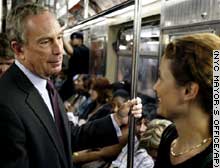Untangling Traffic: Bloomberg’s Forgotten Promise
 On July 11, 2001, Republican mayoral candidate Michael Bloomberg issued a policy paper on traffic and transportation. The paper was called "Untangling Traffic" and it’s opening sentence exclaimed, "Traffic is a mess!"
On July 11, 2001, Republican mayoral candidate Michael Bloomberg issued a policy paper on traffic and transportation. The paper was called "Untangling Traffic" and it’s opening sentence exclaimed, "Traffic is a mess!"
Written with the help of transportation consultant and former DOT Deputy Commissioner "Gridlock" Sam Schwartz, the paper went on to detail some of the costs of New York City traffic congestion, a little bit of the history behind it, and a lengthy set of innovative proposals to solve the problem.
When Michael Bloomberg made these proposals five years ago, many urban observers still believed that traffic congestion was an inevitable and unavoidable byproduct of big city-living. Since then we have learned otherwise.
The city of London, England has successfully implemented a congestion pricing system that has reduced traffic congestion by 35% and is raising nearly 100 million pounds per year for mass transit, bicycle and pedestrian improvements. The city of Paris, France has built hundreds of kilometers of dedicated express bus and bike lanes, turned an urban highway along the River Seine into a summertime beachfront, and made its city center far more friendly to pedestrians and far less amenable to private motor vehicle traffic.
In the last five years, world cities have learned that there are many tools and techniques for solving the problem of traffic congestion. And that reducing traffic congestion is good for a city’s economy and quality of life.
Meanwhile, five years later, traffic in New York City is still a mess!!! You can put three exclamation points on it because, in fact, there are more cars and trucks on New York City streets today than there ever have been. And yet since issuing this policy paper in 2001, the Bloomberg administration has never put forward any plan to tackle the city’s traffic problem. Under the Bloomberg administration New York City has no transportation plan.
Five years later, it is time to revisit candidate Bloomberg’s promises to New York City. This is what the candidate Michael Bloomberg said he would do if elected mayor:
- As Mayor, I would give one person – reporting directly to me – the authority to coordinate the city’s traffic policies and all other transportation-related issues. We must make one person accountable for all peoples’ everyday experience in getting where they want to go.
- As Mayor, I would work with the Governor and the state Legislature to transfer the NYCTA to the City. Recognizing that transportation is a regional issue and the MTA rightly serves Long Island, Connecticut and the five counties north of the city, the new agency would continue to coordinate with the MTA. But when it comes to subways and buses on the streets of New York City, the Mayor should be calling the shots. Period.
- New York is a walking city. Therefore, we must do everything possible to move pedestrians through crosswalks more quickly and safely.
- We have to make the choice between favoring trains, buses, for-hire vehicles – or private cars. Given our objective of helping people versus "hardware," I also would:
-
- Establish a "Subway on the Surface" on the East Side of Manhattan.
- Expand the bus fleet.
- Create additional bus lanes. Consideration should be given to establishing bus priority lanes on Fordham Road, Tremont, Third, and Webster Avenues, and the Grand Concourse in The Bronx; Northern and Merrick Boulevards in Queens; and Capodanno Boulevard on Staten Island.
- Curb Privileged Parking. Curb space is a valuable public resource. There may be as many as 100,000 on-street parking permits issued to city, state and federal employees, judges, diplomats, the press, etc. The fact that no one knows the exact number points to an aspect of this problem. Privileges should be rescinded unless there is a demonstrable need for on-street parking. If the average person doesn’t have special parking privileges, why should those who work for us or write about the traffic "mess" have them?